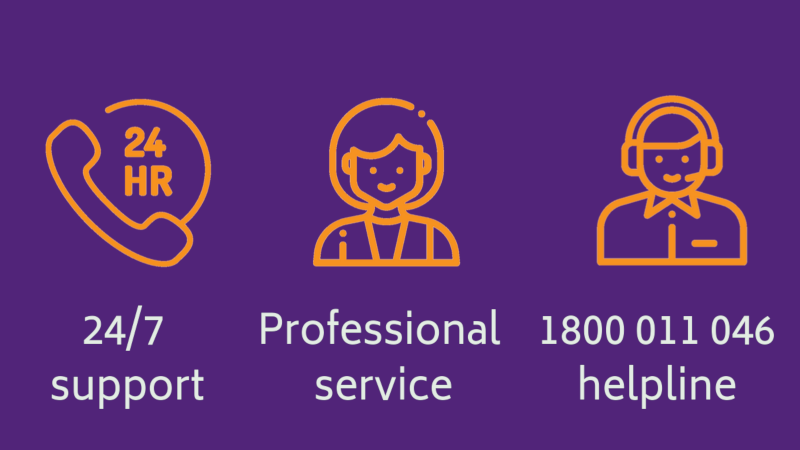Anger
We all get angry sometimes. But if anger is expressed in ways that are harmful to ourselves or someone else, or persists for a long time, it can become a problem.
Do I have a problem with anger?
If you think you have a problem with anger, ask yourself:
- Do you get angry a lot? Do you get angry more often than most people do?
- When you get angry, do you go over and over the situation in your mind and seethe all day?
- When you get angry, does the anger feel so strong that you feel like you might explode or lose control?
- When you get angry, do you become physically or verbally aggressive?
- Do you find that anger affects your relationships with your friends or family?
- Do you find anger interferes with your ability to study or work?
What is problematic anger?
Anger is often a way of showing that we feel frustrated or think we’ve been treated unfairly. But it can also be driven by other feelings like sadness or feeling unsafe or threatened. For example, you might become angry with your son for crossing the road without looking. While you may exhibit anger, you’re not so much angry as afraid for his safety.
Anger can vary in intensity and in the length of time it lasts for:
- It can be brief and ‘explosive’, like when a person flies into a rage. When people experience this type of anger they tend to have strong physical reactions. They might start sweating or feel their muscles tense up or their heart race. Some people can become aggressive or violent when they get angry like this, and end up hurting or threatening other people or damaging things. In these situations, it's important to understand what you are feeling and how you can control your response.
- Long-term anger can turn into resentment. This type of anger tends to be the result of thinking negative thoughts over and over again. It may end in revenge fantasies. In these situations, it's important to think through the issue and think calmly about the event that has made you resentful so you can move on.
Why do I get so angry?
Anger is part of your survival instinct. It allows you to react quickly to unexpected threats.
Reacting to a threat with immediate action (rather than freezing) is an important part of military training. In combat situations, this may mean the difference between life and death. It can help you to cope with threats by giving you the energy to respond quickly, protect yourself and your mates, and keep you going in the face of danger.
The problem is, a lot of veterans have trouble turning off that survival instinct once they get home. This can mean reacting to everyday situations as if they were dangerous or life-threatening.
For example, your wife might forget to buy milk, which is a minor inconvenience. But if forgetfulness pushes a button for you, a reminder that forgetting something in a combat situation can get you killed, you’re more likely to over-react and you may become angry.
For some veterans, anger can be related to another mental health problem like depression, alcohol, drug use or posttraumatic stress disorder.
Posttraumatic stress disorder is linked to anger because if you feel wound up all the time, it doesn’t take much to push you over the edge and trigger an angry outburst.
Anger is also a way to avoid other unpleasant feelings like embarrassment, guilt, anxiety or depression.
Some people use alcohol or other substances to try to manage their anger, but find that it makes their anger worse.
Recognise
Read Phil’s story...
“It was only a few days after I got home that the first shock came. We were driving down the road when a guy just looked across at me and I had this angry outburst like, ‘Have another look mate and I’ll rip your head off.’ Something like that. I’m normally such a passive person and my wife just went, ‘Holy s**t Phil! What was that?’” - Read Phil's story.
What can I do about it?
You may be exhibiting anger but it may be the result of other issues that are affecting your quality of life, such as chronic pain, lack of sleep or even poor diet making you tired.
Anger will often get better on its own once other problems become less severe through treatment. For example, drinking too much has been linked to anger and violence, so reducing alcohol consumption could dramatically reduce incidents of anger.
Self-help
These strategies will help you understand and better manage your anger. For some people, these tools may be all that's needed. Professional support is available for veterans who feel they may require more support.
Take time out
In the heat of the moment, anger can quickly get out of control.
If it does, take a timeout.
By taking time out, you're making a choice to leave a situation before you lose control. Remember 'the four Rs':
- Recognise early warning signs that your anger is about to get out of control. Maybe you get sweaty, red in the face or you clench your fists. If you start doing these things, recognise what is happening.
- Retreat from the situation. Go for a walk, sit outside, play with the dog ... do whatever you need to create distance between you and whatever is making you angry. If you are away from the problem, it will be harder for it to make you angrier. There's nothing wrong with walking away from a bad situation.
- Relax while you’re away from the situation. Do things that will calm you down both physically and mentally. You’ll be more likely to come up with a logical solution to a problem and view things from a different perspective if you’re calm. This may take a few minutes, an hour, whatever. The aim is to defuse the situation in your mind by thinking about it differently.
- Return once you’ve calmed down. Only return when you are sure you can handle the situation without your anger overwhelming you again. If your anger starts to return, start the process again: recognise, retreat, relax and return.
Relax
When we get angry our muscles tense up, ready for a fight.
If you’re angry a lot, you’ll probably be pretty tense all the time and won’t even notice it. This makes it harder to being the process of controlling your emotions. So the first step is learning to recognise tension. Do parts of your body feel tired or ache? Are you grinding your teeth or clenching your fists?
Being able to release tension is a really effective way of managing anger. One simple strategy is to deliberately tense each of your muscle groups (arms, face, back, stomach, legs) in turn, and then relax them completely.
Take action
Release tension and relax your body and mind when you’re angry
Anger often leads to muscle tension, which in turn can lead to aches, pains, fatigue and difficulty thinking clearly.
The Isometrics tool teaches you to release stress in your body by focusing on the areas of your body that feel tense. This is a good tool if you’re short of time.
If you have more time, the Progressive Muscle Relaxation tool teaches you to tense and relax each of the muscle groups in your body so you can calm down and think clearly when you’re angry.
The Progressive Muscle Relaxation tool is also available on the High Res app to use on the go.
Identify unhelpful thoughts
It might seem like your anger is caused by other people or events, but actually it’s the way you think about those events that determines how you react.
People with anger problems tend to think in ways that fuel their anger.
For example:
- You might jump to conclusions ('My wife has been on the phone a lot so she must be having an affair').
- Exaggerate the importance of small things ('Our son can’t make it to the BBQ, so we might as well cancel the whole thing').
- Think in black and white ('He didn’t do that perfectly, so what he did do is useless').
If you can recognise some of your unhelpful thinking patterns, you're in a good position to start challenging them.
Start by asking yourself if there’s another way of looking at the situation. Could you have misunderstood an event, what someone said or misinterpreted their motivations? Are you being fair when thinking about other people's motivations?
Take action
Think about things differently when you’re angry
Use the Challenge Your Thoughts tool to help you to notice your thoughts in situations that upset or bother you. Then you can start to challenge and change any unhelpful thoughts.
This tool is also available on the High Res app to use on the go.
Put things in perspective
When we’re angry, we tend to act without thinking. Especially if we get caught up in the adrenaline rush of anger.
You might find yourself blowing things out of proportion, and then you feel guilty or embarrassed about it later.
When you’re getting angry about something, stop and ask yourself: “Is this really worth getting upset about? Am I overreacting? Is this issue my problem?”
In other words:
- Does this matter?
- Is it worth it?
- Why do I care?
If you're uncertain, rate it. Try rating the situation on a scale from 1 to 10, where 1 means the issue is trivial and really has no effect on you, and 10 means the situation is life-threatening. Anything that scores a 5 or less probably isn't worth getting upset about.
Take action
Get Better Control of Your Anger
Use the Defusing Anger tool to plan which strategies you'll use when you get angry. These strategies will help you to change your physical reactions, behaviours and thoughts.
This tool is available on the High Res app to use on the go.
Does your anger turn to violence
Getting angry is bad enough. Yelling or threatening can destroy relationships and create fear in a household. But when anger turns to violence, the results can be deadly. Learn more about violence.
See also
-

Violence
Violence is never acceptable. If you think you might have a problem with aggressive or violent behaviour, taking responsibility for your actions is the first step to finding more appropriate ways of dealing with difficult emotions. -

Counselling
Open Arms can provide individual, couple and family counselling to help improve your resilience, as well as enhance your mental health and wellbeing. Call 1800 011 046 for free and confidential 24/7 support.






